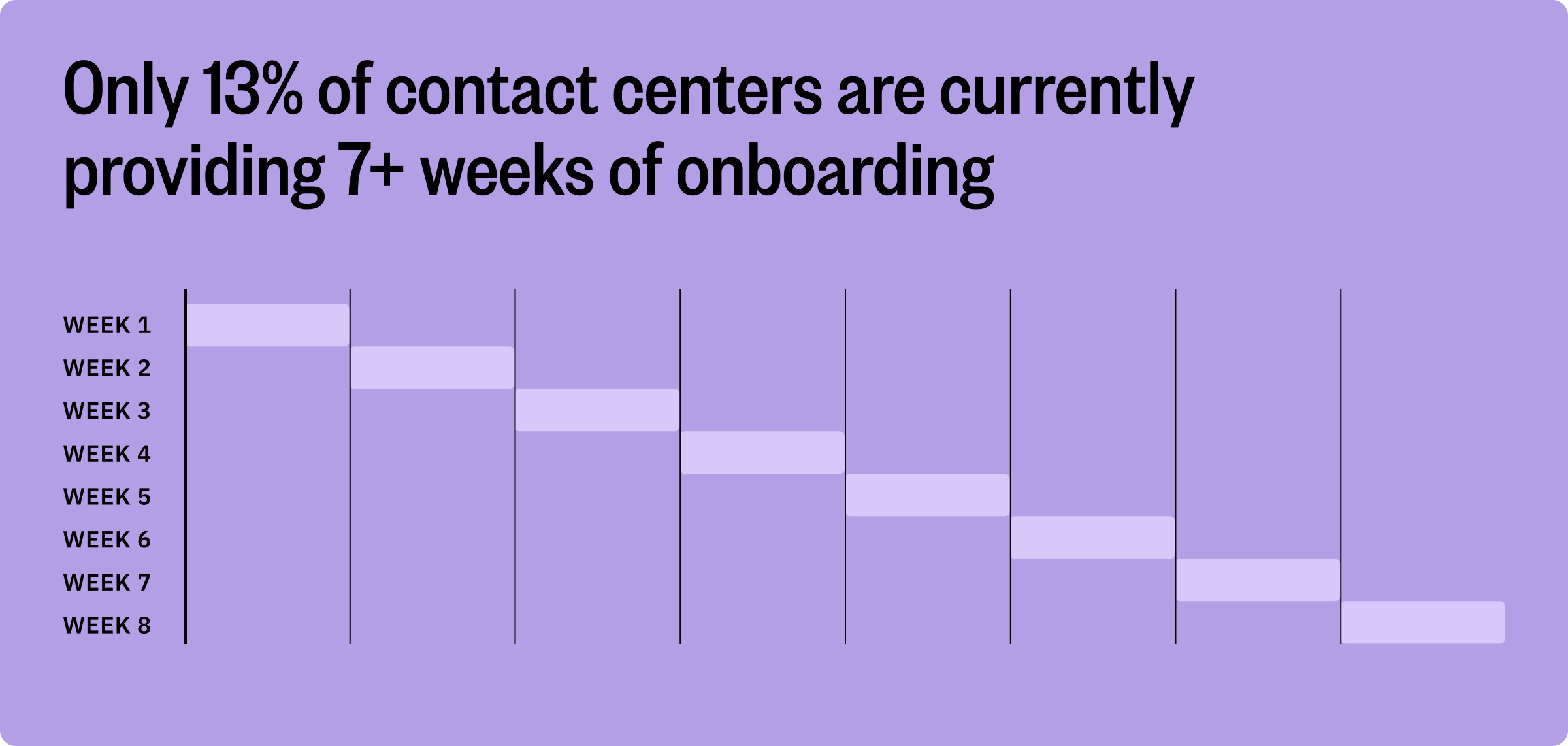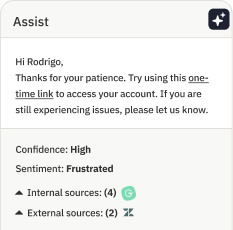Customer support training and onboarding need a makeover: Here's how to do it

Starting a new job can feel like transferring to a different school. For customer support professionals, it’s more like starting at a new school in an unfamiliar town that has an entirely different curriculum — and everything’s taught in a different language.
Working in customer support requires serious skill. Your new employee onboarding program needs to stand up to the demands that agents will face, like needing in-depth knowledge of the organization, being able to rapidly switch from one topic to another, and demonstrating grace under even the most high-pressure situations.
If your customer support onboarding program hasn’t gotten a refresh recently, it’s time to change that. It takes a lot of time and financial resources to onboard new agents, so a solid program is key. And your agents deserve high-quality customer support training that prepares them to excel.
Why customer support onboarding needs to evolve
You’re no stranger to a long list of misconceptions about customer support agents: They do low-skill work, they spend most of their time putting people on hold, and on and on. 🙄
This mindset has been pervasive for decades, which explains why call center jobs have often been more accessible for less-experienced professionals and career changers. But these jobs didn’t pay well, didn’t support employee morale, and didn’t offer benefits — at least not good ones. And let’s not forget the dreaded probation period: a 90-day (or more) window during which agents had to accept a lower wage while they got up to speed.
But agents expect better today because they know they provide a ton of value to their organizations. Not only are they on the front lines helping to resolve customer issues, but they’re also advocating for your organization and providing valuable information about products and services in real time. Who else has as much direct interaction with your customers?
In fact, a report from Lucidworks shows that anywhere between 40% and 70% of support professionals, depending on their industry, consider upselling to be a regular part of their jobs. What’s more, one out of every two customers is likely to take those recommendations. Agents are effectively acting as sales representatives, and companies are slowly starting to recognize that these professionals are aware of the value they provide.
How? Turnover. Today’s customer support agents leave if they’re expected to simply deal with a bad employee experience. In fact, The State of The Contact Center in 2021 from ICMI shows that the rate of agents who leave large contact centers is 37%. This becomes costly when you consider that it can cost up to three times an agent’s salary to onboard someone new. If your agents make $45,000 on average, that equates to $135,000.
Can you afford to see more than one-third of your team pack up and go? That doesn’t even get into the added stress those who remain will face as they try to pick up the slack.
Seeing how complex the role of a customer support agent is probably makes it clear that effective, thorough onboarding is critical. It takes months for agents to become fully proficient. Setting them up for success means making sure they receive 7+ weeks of training, something the ICMI report shows that only 13% of contact centers are currently doing.

If agents are expected to wear so many hats on the job, you need to set aside the time to train them accordingly. You don’t want to send an employee to go work at a construction site, a kitchen, and a hospital with nothing more than a baseball cap. 🧢
The value that effective new employee onboarding programs deliver
Putting so much emphasis on customer support onboarding might seem like an odd approach to improving the employee experience and boosting performance. Offering great pay and benefits certainly makes a difference. But you might be surprised at how much customer support professionals value good training.
As an ICMI article illustrates, there’s a positive correlation between more training and better agent satisfaction. Think about it this way: investing time and resources into your team members shows that you have confidence in their abilities to succeed. It’s a sign that you trust them to do their jobs well. An agent who comes into work feeling like they have your respect is going to feel more positively about their role.
There’s even research that shows some more direct results of effective training. A report from ASAPP shows that among agents who feel they received sufficient, quality training:
- 92% are satisfied with their ability to help customers
- 88% are satisfied with their knowledge of systems
- 77% are satisfied with the support they receive from management
When agents are more satisfied, it trickles down to the customer experience. Zendesk’s 2022 CX Trends Report shows that 81% of customers say they’re more likely to make another purchase after a positive experience. And many of those customers are willing to forgive an organization for a mistake if they receive excellent service. This helps to explain why research from Gartner shows that 86% of executives rank employee engagement as a top factor for improving CX.
Onboarding also gives agents time to understand how your company operates. Even if they’re experienced professionals who’ve been helping to resolve customer issues for years, your organization probably handles certain situations differently. Adapting to new practices simply takes some getting used to.
What every company needs to do to improve customer support training and onboarding
While it’s true that every customer support onboarding program will look a bit different, there are plenty of elements that a quality program needs. Consider each of the below stages to be non-negotiable.
1. Hire the right people first
Because customer support agents have such complex jobs, selecting the right individuals is key. HubSpot points out a few qualities you’ll want to look for:
🤗 Emotional intelligence — Agents will be working with customers at times when they may be feeling frustrated or overwhelmed. Being able to navigate those conversations in a way that’s both empathetic and authentic is critical.
💬 Good communication skills — Customer support professionals spend nearly all their time communicating, whether it’s a live phone conversation or an asynchronous email. They need to be able to convey information clearly and concisely.
🧠 Resourcefulness — The odds are pretty low that an agent will be able to answer every question every time. The best ones will take the initiative to track down answers and help to solve every problem that comes across their plates.
❤️️ Passion for helping customers — Having a desire to go above and beyond to help customers is what makes great agents stand out. Seeking out those who are willing to put in this type of effort means they’ll already have the motivation they need to be successful.

It’s also a good idea to keep your company values top of mind when interviewing candidates. Ask them questions about the way they think, how they approach certain situations, and what they value in colleagues. It’s not just about finding the best customer support agents — it’s about finding the best customer support agents for your team.
2. Hold a formal class where all new employees learn together
Customer support teams that are growing quickly often need to hire a number of agents at the same time. This is actually preferable to bringing on team members one at a time because it enables you to hold a formal training “academy” that every new employee completes together. These types of classes have traditionally been relegated to large enterprises only, but they should really be standard.
During the classroom phase, which should last for a few months, instructors teach new employees about the company and various processes. There’s a fair amount of memorization involved, so it’s useful to administer quizzes to ensure everyone is keeping up with the material.
As new agents continue through their classroom experience, they should progressively get more exposure to customer interactions. Your program might involve having instructors take live calls or chats to provide real-time demonstrations. You could also leverage mock calls that involve a few employee participants and a few observers who provide feedback afterward.
Getting agents used to customer interactions by practicing conversations like this will prove useful later on. According to the ASAPP research, 77% of agents say hands-on training is more effective than reading a manual.
Once agents have completed their formal classroom training, consider administering an onboarding survey. This is a key moment in their training. Collecting feedback now could reveal opportunities for future improvements to the onboarding program.
3. Establish a mentor program
New agents will have learned a lot about the company and best practices once they’ve completed classroom training, but they’re not yet ready to dive into customer interactions. They need to go through another layer of training that focuses more intensively on practical applications.
The best way to do this is through a mentor program where new employees spend time shadowing more experienced support professionals as they work with customers. The new agents can see not only how to navigate conversations but also what resources they can expect to use.
For example, maybe the mentor agent needs to visit the company knowledge base to find the answer to a customer question. The new agent can make note of that and recognize that it’s OK to not always know the answer right off the bat.
How long the mentorship period lasts is up to you, but take a few things into consideration when determining this, such as how many channels of communication new agents will support and how complex customer questions typically are.
4. Plan for a nesting phase
Your new employees are ready to start their roles as customer support agents. But they’re not quite on par with team members who’ve been around for a few years, so you should build a nesting phase into your onboarding program.
ScreenSteps explains that nesting is a transition phase that prepares employees to manage interactions completely on their own. During nesting, new agents can take calls while a more experienced agent observes and prepares to step in if needed. Some support teams also initiate the nesting phase by having new agents provide support only for asynchronous channels, such as email, to begin.
Once new agents are able to confidently navigate conversations without making mistakes or asking for help, they’re ready to take off the training wheels.
5. Continue to provide coaching
You’re never done learning in customer support. Workforce managers are constantly identifying opportunities for improvement by investigating a variety of customer support metrics.
Say an agent’s average handle time (AHT) has been creeping up over the last few weeks. Managers can use that information to come up with some strategies that may help that agent wrap up calls more efficiently without degrading the customer experience.
Coaching is also important in the event that you decide to launch a new channel of engagement. If your team has never provided live chat support before, you should absolutely host several team-wide training sessions dedicated to working with customers on that channel.
6. Prepare more experienced agents to become team leads
Eventually, your new customer support agents won’t be so new anymore. You might start with weekly agent coaching, cut back to bi-weekly coaching, and then eventually shift those coaching sessions into conversations that are more about career progression. Ask agents about their goals and help them find ways to continue growing.
Agents who have an aptitude for educating others and setting a good example can be transitioned into team leads. This is something more and more organizations are doing. The State of The Contact Center in 2021 reports that two-thirds of contact centers have a program in place to help prepare existing agents to take on supervisor roles in the future.
There might not be an actual job opening for this type of role, but supporting an agent in taking on an informal leadership position is a great way to help them take the next step in their career. Who knows? Maybe they’ll be in your shoes one day.
Empower your agents with excellent new employee onboarding
Customer support professionals are sticking up for themselves. They want meaningful jobs at companies willing to provide them with a supportive environment that helps them be their best in both their personal and professional lives.
Effective customer support training plays a huge role in this. It equips agents with the knowledge, skills, and confidence they need to excel at their jobs. With a high-quality onboarding and training program, you can truly empower your employees to reach their career goals.
But don’t stop at revamping your onboarding processes. There are so many other ways you can ensure you’re providing the type of workplace experience that agents deserve. Everything from offering flexible scheduling to upgrading your software can make a difference.
Discover all the ways you can improve the employee experience — without sacrificing your workforce planning needs.





